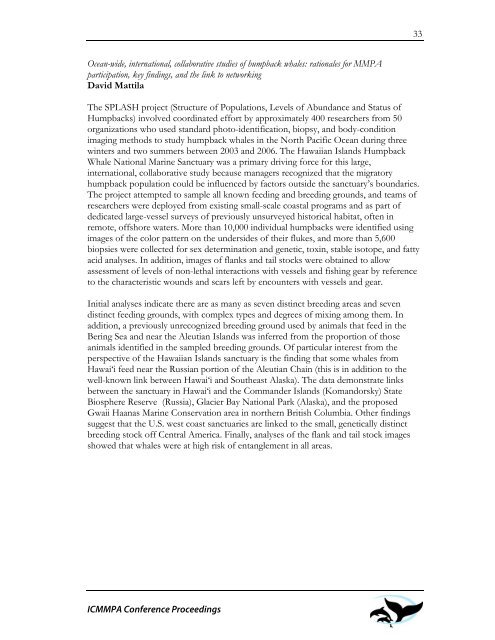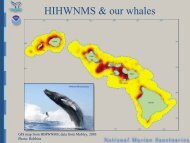The First International Conference on Marine Mammal Protected Areas
The First International Conference on Marine Mammal Protected Areas
The First International Conference on Marine Mammal Protected Areas
You also want an ePaper? Increase the reach of your titles
YUMPU automatically turns print PDFs into web optimized ePapers that Google loves.
Ocean-wide, internati<strong>on</strong>al, collaborative studies of humpback whales: rati<strong>on</strong>ales for MMPA<br />
participati<strong>on</strong>, key findings, and the link to networking<br />
David Mattila<br />
<str<strong>on</strong>g>The</str<strong>on</strong>g> SPLASH project (Structure of Populati<strong>on</strong>s, Levels of Abundance and Status of<br />
Humpbacks) involved coordinated effort by approximately 400 researchers from 50<br />
organizati<strong>on</strong>s who used standard photo-identificati<strong>on</strong>, biopsy, and body-c<strong>on</strong>diti<strong>on</strong><br />
imaging methods to study humpback whales in the North Pacific Ocean during three<br />
winters and two summers between 2003 and 2006. <str<strong>on</strong>g>The</str<strong>on</strong>g> Hawaiian Islands Humpback<br />
Whale Nati<strong>on</strong>al <strong>Marine</strong> Sanctuary was a primary driving force for this large,<br />
internati<strong>on</strong>al, collaborative study because managers recognized that the migratory<br />
humpback populati<strong>on</strong> could be influenced by factors outside the sanctuary’s boundaries.<br />
<str<strong>on</strong>g>The</str<strong>on</strong>g> project attempted to sample all known feeding and breeding grounds, and teams of<br />
researchers were deployed from existing small-scale coastal programs and as part of<br />
dedicated large-vessel surveys of previously unsurveyed historical habitat, often in<br />
remote, offshore waters. More than 10,000 individual humpbacks were identified using<br />
images of the color pattern <strong>on</strong> the undersides of their flukes, and more than 5,600<br />
biopsies were collected for sex determinati<strong>on</strong> and genetic, toxin, stable isotope, and fatty<br />
acid analyses. In additi<strong>on</strong>, images of flanks and tail stocks were obtained to allow<br />
assessment of levels of n<strong>on</strong>-lethal interacti<strong>on</strong>s with vessels and fishing gear by reference<br />
to the characteristic wounds and scars left by encounters with vessels and gear.<br />
Initial analyses indicate there are as many as seven distinct breeding areas and seven<br />
distinct feeding grounds, with complex types and degrees of mixing am<strong>on</strong>g them. In<br />
additi<strong>on</strong>, a previously unrecognized breeding ground used by animals that feed in the<br />
Bering Sea and near the Aleutian Islands was inferred from the proporti<strong>on</strong> of those<br />
animals identified in the sampled breeding grounds. Of particular interest from the<br />
perspective of the Hawaiian Islands sanctuary is the finding that some whales from<br />
Hawai‘i feed near the Russian porti<strong>on</strong> of the Aleutian Chain (this is in additi<strong>on</strong> to the<br />
well-known link between Hawai‘i and Southeast Alaska). <str<strong>on</strong>g>The</str<strong>on</strong>g> data dem<strong>on</strong>strate links<br />
between the sanctuary in Hawai‘i and the Commander Islands (Komandorsky) State<br />
Biosphere Reserve (Russia), Glacier Bay Nati<strong>on</strong>al Park (Alaska), and the proposed<br />
Gwaii Haanas <strong>Marine</strong> C<strong>on</strong>servati<strong>on</strong> area in northern British Columbia. Other findings<br />
suggest that the U.S. west coast sanctuaries are linked to the small, genetically distinct<br />
breeding stock off Central America. Finally, analyses of the flank and tail stock images<br />
showed that whales were at high risk of entanglement in all areas.<br />
ICMMPA <str<strong>on</strong>g>C<strong>on</strong>ference</str<strong>on</strong>g> Proceedings<br />
33



